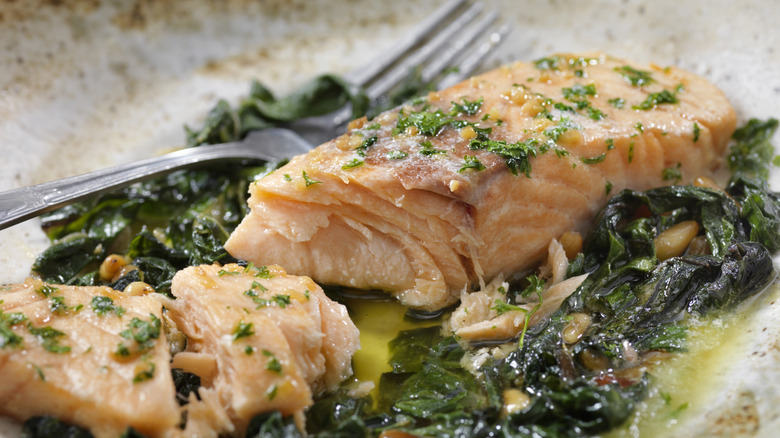How To Choose The Best Meat To Poach
For as long as humans have been cooking, we've been putting food in liquid and seeing what happens. Boiling is the easiest way to prepare food for beginners — great for things like pasta and potatoes, but you don't want to boil a steak or Brussels sprouts if you want them to be at their tastiest. But it's also not the only method: for hundreds of years, human beings have also been poaching their food, submerging it in a liquid (usually not water, unlike boiling) and cooking it on lower heat for a longer period.
But while you probably know some foods typically associated with poaching, you might wonder, "What else can I poach aside from an egg?" We spend a lot of time exploring culinary frontiers in modern society, so what can we add to the poaching roster? It turns out the answer is ... well, pretty much anything, including meat, so long as you're picking the best type.
The poaching possibilities are nearly limitless
There are some proteins you associate with poaching because they're the ones we most commonly see in America, and the classics are classic for a reason. Seafood — not just fish, but also crustaceans and mollusks — is the classic poaching protein, and it makes sense that creatures that live in liquid would hold up well to poaching. Chicken breast takes especially well to poaching because it properly absorbs liquid — and you can actually poach an entire chickenn. You see a lot of poached recipes for pork tenderloin and pork chops for similar reasons.
The possibilities also don't end there. We think of poaching beef as anathema in America, but it's actually pretty common in Europe. Sirloin strips and rump roast will serve you best here. Brisket also takes well to poaching for the same reason it takes well to braising (but doesn't to high heat methods like grilling). Low and slow cooking methods help draw out the collagen and infuse the meat.
Obviously, there are a couple of meats that cook a bit differently if you poach them. Steak is technically possible, but it's not going to be remotely as good as traditional cooking methods involving searing and basting. Ground beef or other ground meats aren't going to hold up to the process and you'll basically wind up making a poached sauce. But aside from those, most things can take well to poaching if you do it right.
Poaching and sous vide are also entirely different concepts
It's important to note that poaching and sous vide — which are sometimes confused for each other — are very different. Both involve submerging a food (usually a protein) in a liquid, and both are done at much lower temperatures than boiling, but that's where the similarities end. Sous vide is always done in water, with meat that's been sealed in a vacuum package so that nothing comes in direct contact with the water itself. Poaching can be done in a number of liquids and is intended to get the flavors of those liquids deep into the food.
Also, while poaching is usually the only part of the cooking process, sous vide is sometimes merely a part of it. A salmon that's been subject to sous vide is left alone, sure, but not so for beef. Steaks that are sous vide are still typically seared either before or afterward, so you don't get a lump of gray meat. Poaching is like anything any other cooking method: how you prepare your dish depends entirely on which meat you're talking about.


